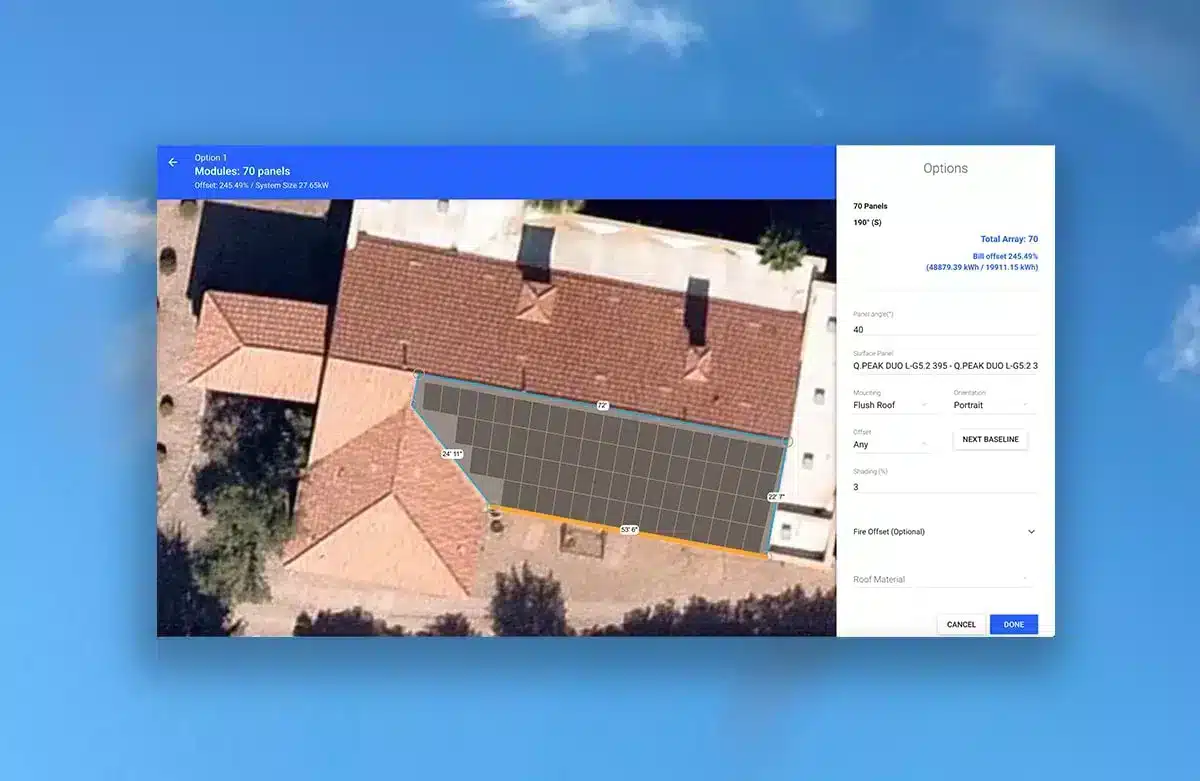
In the time since we’ve launched Solargraf we’ve received many questions from solar installers, both new to the industry and seasoned pros about getting the most of our software. This is why we’ve decided to put together this installer FAQ for all things related to solar software and your business.
Q: How do I grow my solar business?
A: In order to successfully grow and scale a business, you’ll need an action plan. If you’re in a highly competitive area, you’ll need to be quick on your feet and ready to whip up quotes at any time.
Find a solar sales tool like Solargraf that allows you to do everything you need within the software at the click of a button. If you have all your pricing, materials and options preloaded into a tool and ready to go, there’s no reason why you shouldn’t be saving time on generating proposals and transferring that to making sales.
Cutting out the separate tools you may have been using to calculate your pricing, generate your quotes, write up your contracts, apply for financing and order permits will leave you more time in your day to expand your business.
The extra time you gain can be used to market your business, keep an eye on solar energy trends and new products, hire staff to handle the increase in projects, build your brand and generate more leads to support it all! Our blog is also a great place to spend some time learning some tips to increase your sales.
Q: Why do I need a solar quote software?
A: Even though solar panels have technically been around since the 1800’s, they’ve only become efficient and affordable enough to be worth buying since the 2000’s – coincidentally around the same time that internet technology began to really take off in the all-encompassing way that it is now.
While using a solar software on Windows 95 on a large, clunky desktop would have been a torturous task, it is now almost impossible to get by in the solar industry without a design software/project manager on your phone or tablet.
Being able to calculate the costs and savings of a system, all while taking into account utility rates, financing options, loans, leases, and PPAs, etc. at the click of a button is no longer a perk, it’s a necessity in solar sales.
If every other solar designer is using a proposal tool, they will definitely beat the person who has to run back to the office and their spreadsheets in order to put together a sales proposal. This means that you need to get on their level and find a solution that fits your needs to stay ahead of the game.
Q: How do I make a winning proposal?
A: Arguably the most important part of the sales process, the presentation of your solar proposals often can make or break your sale.
Above all, your quotes need to be as easy to understand as possible. It’s important to remember that most homeowners might not know what the words “photovoltaic system” mean or what incentives or rebates they might have access to and how they apply to their final price.
Laying out everything in a simple, linear way will make it infinitely easier for someone to see exactly how much their system will cost, how much they’ll save and why. They also won’t feel as though they’re being taken advantage of with costs hidden in multiple places on the page.
You’ll also want to consider different types of buyers and check off boxes on your proposals for both. Do you have someone looking into solar power simply because they want to save money? Make sure to clearly emphasize their solar savings. What about the person who is considering renewable energy for environmental reasons? You’ll also want a section on the quote detailing the impact their system will have on the environment.
Q: What’s the best way to calculate my material costs?
A: The best way to calculate your material costs is to not calculate them at all. If you are a Solargraf subscriber, you can add every material and extra cost imaginable into your account for easy use on your projects. Set up your defaults on your Settings page and Solargraf will apply them to your projects at the click of a button.
You can add every panel you use, your default pitch and system losses, energy degradation and default system losses. On top of that you can also set up a full price table, financing options offered and default incentives available to your clients among others.
It’s also incredibly easy to add any discounts and extra costs to your account as well. Do you offer a free Nest thermostat if your client buys a system? Add it to Solargraf to show it on your quotes. What about a discount in the down season if a purchase is made by a certain date? This can also be set up in your account to help you close that deal.
Q: How do I choose a solar panel software for my business?
A: Choosing a software is easy if you know what you’re looking for. You’ll want to make sure that you can use it for every step of your sales process and you’ll need it fit all your needs as an installer.
If you want to grow and thrive in this ultra-competitive business, your software needs to do more than send a simple quote for you. Your proposals should be slick, easy to read and customizable to your needs. They need to display all the details of the system including the panel layout, shading analysis details, different purchase/loan options, solar design, and financing.
Your clients should be able to sign on the dotted line without ever leaving the page and you should have a robust set of tools on the backend such as being able to set different roles and permissions for your users, pick who gets to see what and who gets notifications for the projects they are responsible for.



 United States
United States Germany/Austria
Germany/Austria Brazil
Brazil Netherlands
Netherlands